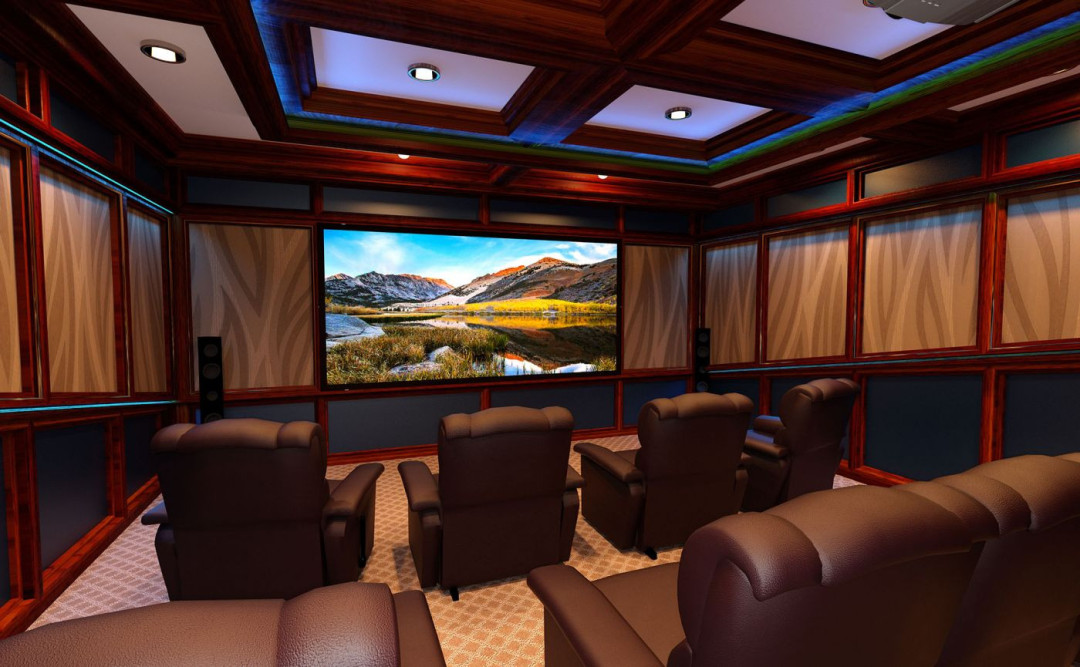Home theaters have come a long way in the last few years. What was once an extravagance available only to the super-rich is now within reach of many homeowners. Where projectors and DVDs once ruled, large screen TVs and streaming services have become major players. And home theaters may not only be about movies. With ultra-high resolution television and gaming, home theaters can do a lot more than just screen the latest blockbuster.
Home Theater Basics
The perfect home theater experience means different things to different people. But the basics remain the same. A home theater needs a large, high-resolution picture and sound that blows you away.
To achieve amazing sound, most new home theaters use 7.1 surround sound. The 7 refers to the seven main speakers: left, right, and center if the front of the room; left and right in the rear; and two surround speakers on the left and right sides in the middle of the room. The .1 is the subwoofer, which can be placed anywhere other than in a corner. The subwoofer lends weight to movie and video game audio, especially in action films/games with sound effects such as explosions.
High-resolution screens have come a long way and are still evolving. Once, the projector was king. Today, more and more home theaters are built with ultra-HD large-screen televisions. There are a few different technologies in use for the most modern ultra-HD televisions. Which you choose is a matter of personal preference plus budget restrictions. Most electronics stores have some of their best screens on display, so you can decide which picture you like best.
The Guts of Your Home Theater
The beating heart of your home theater is the A/V rack. An A/V rack has all of the technology that drives your home theater. That may include a DVD and BluRay player, a streaming box (like a Roku or similar device), a video gaming system, a cable box, and an audio tuner. Many of these components will require wiring, although many newer devices now use wifi or Bluetooth to connect. It is crucial to build a dedicated A/V rack that will not only keep your components neat but will keep them cool. Many of your A/V devices create heat, and overheating can shorten their lifespan or even destroy them.
To keep your theater clear of wires, consider running wiring through the walls. If that’s not an option, you can run wires in a soffit along the perimeter of the room.
Ambient Light and Sound
When you walk into a movie theater, the world around you disappears. For 90 minutes or more, you can focus only on the movie you are watching. To get a similar effect at home, you need to block as much ambient light and sound as possible.
To block ambient light, you will need to block off any windows. If your home theater is in the basement, that should be pretty easy. If it is above ground, you can permanently close of windows with drywall, or you can cover them with blackout shades. Beware of light seeping in from the door, too. Something as simple as a little weatherstripping can block unwanted light.
When it comes to sound, you want to keep sounds from outside the theater out, but you also want to keep loud noises, especially bass sounds, from rattling the rest of your house.
To insulate your home theater from outside noise, you can cover the walls in an extra layer of specially-designed sound-absorbing sheetrock. Another technique is to place thick curtains over the wall. Of course, you can also use acoustic foam insulation of the sort you find in recording studios. For doors, replacing a hollow door with a solid door will make a huge difference.
Lighting Your Home Theater
Once you have eliminated ambient light, you will need to create some lighting for your theater. Here, dimmers are your friend. One lighting design is to use overhead recessed lighting on a dimmer switch. You can also install soffit lighting, which is just rope lighting installed in a groove that runs around the perimeter of your room near the ceiling. For a more traditional theater feel, consider wall sconces.
Theater Furniture
If you search online for home theater furniture, you will quickly find that it’s easy to blow your budget on top-end theater furniture. However, you don’t need to break the bank. And comfy chairs will do. Avoid any furniture with a high back that could block the view of viewers in the rear. Also, look for soft furniture. Hard surfaces reflect light and sound and can ruin the theater experience.
Professional Home Theater Installation
If you have a DIY spirit and knack for construction, you might be tempted to build a theater yourself. While that’s not a bad idea, there is certainly no comparison to professional design and installation. Intuitive AV can bring your dreams to life. They will work with your budget to create a theater you will love.https://www.trustdale.com/business/ga/woodstock/intuitive-av-home-theater-atlanta

